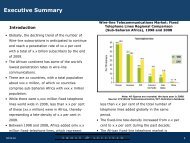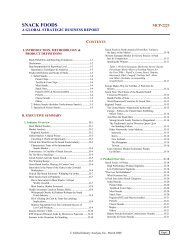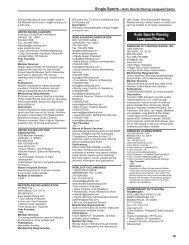Create successful ePaper yourself
Turn your PDF publications into a flip-book with our unique Google optimized e-Paper software.
<strong>IMS</strong> COM PANY PRO FILES TAKEDA<br />
Re cent meta-anal y ses have sug gested that the risks as so ci ated with rosiglitazone may be higher than<br />
those as so ci ated with pioglitazone, par tic u larly when used in el derly pa tients. In No vem ber 2008, a ret -<br />
ro spec tive study pub lished in the Ar chives of In ter nal Med i cine, which looked at about 14,000 pa tients on<br />
Medicare (i.e., older than 65) who were pre scribed Avandia be tween 2000 and 2005, and com pared<br />
these pa tients to 14,000 who were get ting Actos, found that the pa tients who started on Avandia had a<br />
15% higher ‘deaths from all-cause’ rate than the Actos group. The Avandia group had a 13% higher rate<br />
of CHF, but no dif fer ence in the in ci dence of strokes and MI (Avandia in pre vi ous stud ies was linked with<br />
an in creased in ci dence of MI). The au thors con cluded that al though pre vi ous stud ies have in di cated that<br />
the in creased risk with rosiglitazone use re sides pre dom i nantly in car dio vas cu lar out comes, the above<br />
study sug gests that dif fer ences in all-cause mor tal ity risk may be even more im por tant to con sider in el -<br />
derly pa tients. Re gard ing the fact that no dif fer ence in MI be tween the two groups was ob served, the re -<br />
search ers said that since 75% of di a bet ics die from heart-re lated causes, the re search ers think MIs and<br />
strokes likely contributed to the overall increased deaths in the Avandia group<br />
In Oc to ber 2008, new rec om men da tions from ex perts at the Eu ro pean As so ci a tion for the Study of Di a -<br />
be tes and the Amer i can Di a be tes As so ci a tion no lon ger backed the use of Avandia for treat ing Type 2 di a -<br />
bet ics: the rec om men da tions have re tained a ref er ence to the use of Actos, how ever. In the same month,<br />
there was a call by the US ad vo cacy group Pub lic Cit i zen for Avandia to be banned due to a high num ber of<br />
re ports of liver fail ure and death in patients taking the drug.<br />
In creased risk of frac tures in women was also re ported in 2007 with Actos in anal y sis of data con cern ing<br />
over 15,000 pa tients; fur ther anal y sis re ported in 2008 re vealed that the drugs could dou ble this risk.<br />
GSK had pre vi ously warned the FDA of sim i lar risk with Avandia. Fur ther ev i dence in 2007 has as so ci ated<br />
Avandia with links to os teo po ro sis from a com bi na tion of de creased bone for ma tion and in creased bone<br />
re sorp tion al though re sults are in con clu sive to date. As such, the FDA has ad vised healthcare pro fes sion -<br />
als to con sider the risk when pre scrib ing these prod ucts. Re sults of an other study in 2008 showed a dou -<br />
ble or tri ple in crease of bone frac ture in pa tients tak ing the thiazolidinediones over con trol pa tients and<br />
re search ers be lieve that as well as sen si tiz ing the body to in su lin, these drugs also stim u late bone<br />
resorption, making the bones vulnerable to fracture.<br />
Byetta’s (exenatide) im pact on blood glu cose con trol, and par tic u larly its weight re duc ing prop er ties,<br />
gives it a pro file that is very at trac tive to doc tors. Mor gan Stan ley an a lysts think that the DPP-IV in hib i tors<br />
are more likely to be used in ear lier stage dis ease and there fore should not be seen as di rectly com pet i tive<br />
with drugs like Avandia/Byetta. How ever, MS be lieves that the DPP-IV class has sec tor re shap ing po ten -<br />
tial in the same way as PPIs did in the GI field and ACE in hib i tors did in car dio vas cu lar and statins did in<br />
cholesterol.<br />
The FDA is now call ing for higher safety stan dards in ap prov ing di a be tes drugs and the risk ben e fit pro file<br />
of other di a betic drugs is also in ques tion, in clud ing Merck & Co’s DPP4 in hib i tor Januvia<br />
(sitagliptin),which was the first in class fol low ing its US launch in Oc to ber 2006, and is now the ‘gold stan -<br />
dard’ for this class and has had a sig nif i cant im pact. Merck & Co has also launched a com bi na tion prod uct<br />
Janumet (sitagliptin + metformin) in some mar kets. Januvia has been launched in the USA and across<br />
Eu rope and is pend ing ap proval in Ja pan and many other mar kets. Januvia has per haps bene fited from<br />
the neg a tive pub lic ity for Avandia, par tic u larly as it is re ported to have a better side ef fect pro file than<br />
TZD drugs and is as so ci ated with a lack of weight gain. How ever, on the neg a tive side, the DPP-IV path -<br />
way is com plex and long-term prod uct use is as yet un tested. If ap proved, Takeda’s SYR 322 will be the<br />
sec ond DPP-4 in hib i tor af ter Januvia. Novartis’ Galvus (vildagliptin) has been ap proved in the EU where<br />
it is now be ing rolled out, but has faced safety con cerns in the US and fol low ing safety stud ies, fil ing may<br />
now be de layed un til 2010. Galvus was filed for ap proval in Ja pan in April 2008A fil ing in Ja pan is ex pected<br />
in April 2008. In 2007, an ar ti cle in the New Eng land Jour nal of Med i cine ques tioned the safety data avail -<br />
able for the drugs Januvia and Galvus writ ing that it was surprising the FDA decided to clear Januvia given<br />
the questionability of safety data.<br />
© 2009 <strong>IMS</strong> Health In cor po rated or its af fil i ates Page 26









